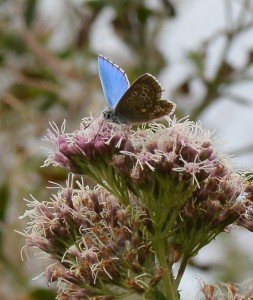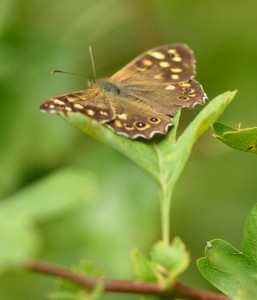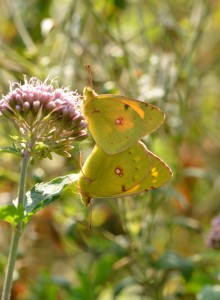Butterflies bounce back after two tough years

Sept 11: This summer was been a great one for butterflies. The cold spring was hard species like orange tip but a very mild June, hot July and temperate August was great for species like peacocks, small tortoiseshell, and both small and green-veined whites. Painted ladies and red admirals will have another wave of emerging adults this month and many peacocks currently around will overwinter as adults.
Today as I walk up the path along our perimeter fence by the trees I am struck by the large number of speckled wood butterflies I see. Almost every 50 feet I find another male patrolling a patch of sunlight looking for females to mate. Any male who enters his territory is engaged in an aerial dogfight and chased off. They will produce at least three generations in a good season with caterpillars feeding up on grasses to overwinter in a chrysalis state.

Autumn is making inroads on the plant life along the pathway. Plump blackberries are almost ready for picking, a tempting treat but we leave them for the dormice and other hedgerow residents. Several shield bug nymphs try to obscure themselves among the leaves on the bramble. Gelder rose berries glow a glace cherry red and elderberries are now a shiny black.
I carefully examine leaves on a clump of nettle. Many have been rolled into tubes, housing tiny moth caterpillars. On a crack willow tree sawfly larvae have homes inside the red galls on leaves while leaf mining beetle larvae leave a meandering pattern in the leaves surface after selectively eating the layers inside that contain the least amount of cellulose.
The pathway widens to a small triangular wet meadow beside the boat safari channels. Here I spot a pair of clouded yellow butterflies chase each other, then pause to mate. Further on around the path Is a big surprise - an adonis blue butterfly is atop a bunch of hemp agrimony. Adonis blue is a chalk downland species scarce in UK but common on the south downs which is the northern tip of it habitat range.

I look up to see the turrets and walls of Arundel Castle framing the reserve. A pair of peregrines cry out, circling amid a swirl of swallows, house and sand martins above the reserve.
Paul Steven's weekly Wildlife Sightings column appears in the Chichester Observer, the Littlehampton Gazette, the Bognor Regis Observer, the Shoreham Herald and the Worthing Herald.

